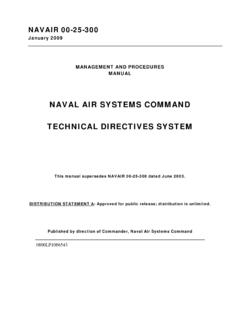Transcription of Chapter 2 Basic Heat Treatment - NAVY BMR
1 Chapter 2 Basic heat Treatment Topics heat Treatment Theory Stages of heat Treatment Recognizing heat Colors for Steel Types of heat Treatment Quenching Media To hear audio, click on the box. Overview Welding, cutting, or even grinding on metal produces heat , which it turn has an effect on the structure of the metal. As a Steelworker, you need to understand the effect that heat Treatment has on metals so you can attain the desired properties for a particular metal.
2 You also need to know what meth ods can be used to restore a metal to its original condition. heat Treatment is the process of heating (but never allowing the metal to reach the molten state) and cooling a metal in a series of specific operations which changes or restores its mechanical properties. heat Treatment makes a metal more useful by mak ing it stronger and more resistant to impact, or alternatively, mak ing it more malleable and ductile. However, no heat -treating procedure can produce all of these characteristics in one operation; some properties are improved at the expense of others.
3 For example, hardening a metal may make it brittle, or annealing it may make it too soft. Objectives When you have completed this Chapter , you will be able to do the following: 1. Describe the heat tre atment theory. 2. Identify the stages of heat Treatment . 3. Recognize heating colors associated with steel. 4. Describe the different types of heat Treatment . 5. Describe the different types of quenching media. Prerequisites None NAVEDTRA 14250A2-1 This course map shows all of the chapters in Steelworker Basic .
4 The suggested training order begins at the bottom and proceeds up. Skill levels increase as you advance on the course map. Introduction to Reinforcing Steel S T E E L W O R K E R B A S I C Introduction to Structural Steel Pre -Engineered Structures: Buildings, K-Spans, Towers and Antennas Rigging Wire rope Fiber Line Layout and Fabrication of Sheet-Metal and Fiberglass Duct Welding Quality Control Flux Core Arc Welding-FCAW Gas -Metal Arc Welding-GMA W Gas -Tungsten Arc Welding-GTAW Shielded Metal Arc Welding-SMAW Plasma Arc Cutting Operations Soldering, Brazing, Braze Welding.
5 Wearfacing Gas Welding Gas Cutting Introduction to Welding Basic heat Treatment Introduction to Types and Identification of Metal NAVEDTRA 14250A2-2 Features of this Manual This manual has several features which make it easy to use online. Figure and table numbers in the text are italicized. The figure or table is either next to or below the text that refers to it. The first time a glossary term appears in the text, it is bold and italicized. When your cursor crosses over that word or phrase, a popup box displays with the appropriate definition.
6 Audio and video clips are included in the text, with an italicized instruction telling you where to click to activate it. Review questions that apply to a section are listed under the Test Your Knowledge banner at the end of the section. Select the answer you choose. If the answer is correct, you will be taken to the next section heading. If the answer is incorrect, you will be taken to the area in the Chapter where the information is for review. When you have completed your review, select anywhere in that area to return to the review question.
7 Try to answer the question again. R eview questions are included at the end of this Chapter . Select the answer you choose. If the answer is correct, you will be taken to the next question. If the answer is incorrect, you will be taken to the area in the Chapter where the information is for review. When you have completed your review, select anywhere in that area to return to the review question. Try to answer the question again. NAVEDTRA heat Treatment THEORY All heat -treating processes are similar because they all involve the heating and cooling of metals.
8 However, there are differences in the methods used, such as the heating temperatures, cooling rates, and quenching media necessary to achieve the desired properties. The heat treat ment of ferrous metals (metals with iron) usually consists of annealing, normalizing, hardening, and/or tempering. Most nonferrous metals can be annealed, but never tempered, normalized, or case hardened. To s uccessfully heat treat a metal, you need to have the proper equipment with close control over all factors relevant to the heating and cooling.
9 For example, the furnace must be the proper size and type with t he temperatures controlled and kept within the prescribed limits for each operation, and you must have the appropriate quenching media to cool the metal at the correct rate. The furnace atmosphere itself affects the condition of the metal being heat treated. This atmosphere consists of the gases in the furnace s heating chamber that circulate and surround the metal being heated. In an electric furnace, the atmosphere is either air or a controlled mixture of gases.
10 In a fuel-fired furnace, the atmosphere is a mixture of gases and air. A ir combines with gases released by the fuel s combustion resulting in various proportions of carbon monoxide (CO), carbon dioxide (2CO), hydrogen (H), nitrogen (N), oxygen (O), water vapor (OH2), and other various hydrocarbons (nnHC2). W hen you vary the proportions of air and fuel in a fuel-fired furnace, you can provide three distinct atmospheres: oxidizing, reducing, and neutral. STAGES of heat Treatment You accomplish heat treat ment in three major stages: Stage l heat the metal slowly to ensure a uniform temperature.
















